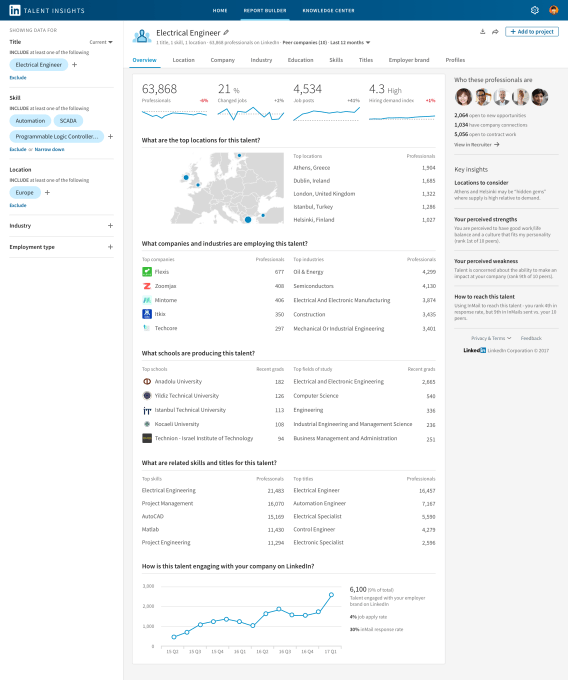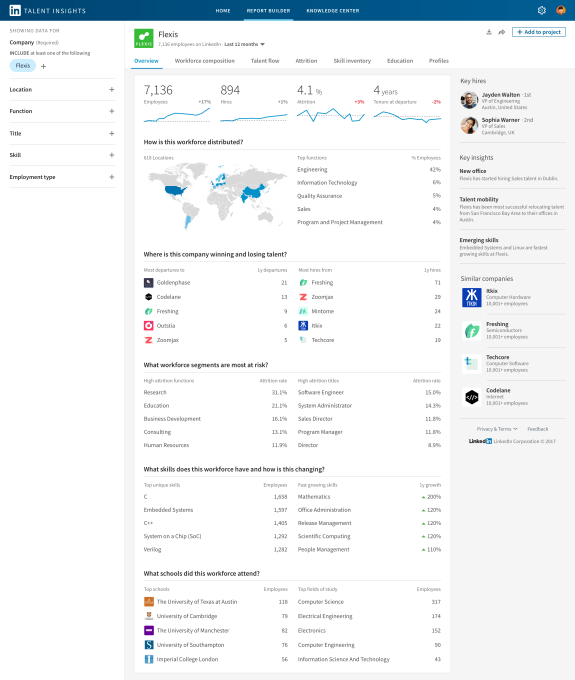LinkedIn, the Microsoft-owned social network for the working world with some 500 million members, has made a large business out of recruitment — with some 11 million job listings on the site at any given time, and the recruitment market providing the company with its largest source of revenue.
Now it is taking another step ahead in building out that business with a new product: LinkedIn Talent Insights, a self-service, big data analytics product that will let recruiters make deeper queries into statistics for hiring and employment, based on LinkedIn data.
Talent Insights is being announced in a closed beta today at the company’s Talent Connect event, with a full launch in 2018. It will be a paid product, Eric Owski, LinkedIn’s head of product for talent insights, tells me, although pricing will not be made public until it’s generally available next year.
Talent Insights will come, initially, with two views, called “Talent Pool” and “Company report.”
The first of these will let recruiters search on different parameters related to specific jobs that they may want to fill — for example, a typical kind of search LinkedIn envisions might be used here is, what schools are producing the most successful data scientists or natural language processing engineers; or which industries (or companies) have been recruiting the most computer vision specialists. 
The Company report, meanwhile, will provide a similar kind of dive but into recruitment patterns at your own company and your competitors — including a look at what skills are growing the fastest and which cities employees are living in. The idea here is not to simply gain competitive intelligence but to improve how you are approaching recruitment yourself.

LinkedIn has made a couple of acquisitions in the past of recruitment startups — specifically Careerify and Connectifier — companies that have built big data solutions to approach the process of hiring and searching for good people in a more modern way. Some of that expertise has already started to make its way into LinkedIn products, and I suspect some of it is coming through here, too.
But this doesn’t appear to be a replacement for searches of specific candidates. Rather, it’s a tool that will sit alongside the search features that LinkedIn already provides (a basic search for free users, a more enhanced one for premium subscribers, and the full-monty for those who take the top subscription tiers in LinkedIn’s membership plans), and provide more high-level insights into hiring trends at your own company, at other companies, within industries, professions and geographic locations.
“I think talent leaders will be the audience for this product,” said Owski, “professionals who have visibility into the day-to-day operations but also have a role to play in strategic planning, and to align a company’s talent strategy with its business strategy.”
It sits alongside other products and features that LinkedIn has been building out to help connect the dots between users and jobs and recruiters a bit more, such as Open Candidates, a way for users to quietly signal to the world of recruiters that they are open to considering new jobs, without letting people at their current organization or any others for that matter know what they are doing.
The significance of this new product for me is that it’s another indication of how LinkedIn is continuing to build out the parts of its business that have been strong revenue generators up to now.
And as it faces more and more competition from others that are hoping to inch into the recruitment space — most recently Facebook, which has been building out its own job listings business (most recently with a partnership with ZipRecruiter) — LinkedIn is looking for ways of keeping people coming back to its site over the others.
Offering more insights beyond job ads with tools like data analytics is one way of tying people to the platform, and as a paid tool you could even potentially envision a time when even if you are using LinkedIn for some of your recruitment budget, you might use it just for the analytics alone to help form wider recruitment strategies.
That’s assuming, of course, that people are not lying on their LinkedIn profiles. It’s still hard to know just how much of the data on LinkedIn is verified beyond people policing themselves — since you are not required to, say, give and verify a TechCrunch email when noting that you work for TechCrunch — and perhaps companies sometimes getting proactive on the platform. LinkedIn also has yet to launch verified profiles on the platform.
It’s also interesting to me because people have long known that LinkedIn is a massive data repository. Much of that data crunching has been done behind closed doors and for LinkedIn’s own purposes — sometimes leading to people saying LinkedIn is “creepy” because of the uncanny connections (and suggestions of connections) that it seems to make between people.
Now, it’s essentially opening up some of that analytics to its users.
Longer term, it will also be interesting to see how and if LinkedIn tries its hand and expanding this platform to more than just recruitment.
The company has been trying for years to evolve its reputation from simple job hunting and networking site to a place where people go to enrich their “professional selves” — be it through reading news relevant to their fields, or reading (and writing) thought pieces from people in those fields. It seems like a logical step to expand Talent Insights into “Professional Insights” down the line to continue to evolve that wider opportunity.
For now, though, the emphasis will be on using LinkedIn’s own data and keeping the focus squarely on recruitment.
“We are going to expand the number of questions that we can answer for talent professionals,” Owski said. “We are already answering critical questions that no other product answers in this way about the labor market.”
